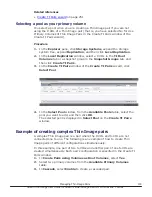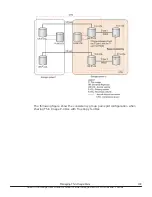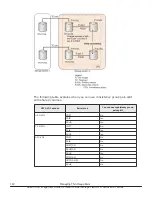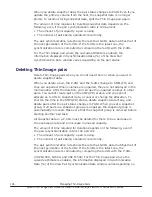
When you delete snapshot data, the pair status changes to PAIR. Even if you
update the primary volume from the host, the snapshot data is no longer
stored. To resume storing snapshot data, split the Thin Image pair again.
The amount of time required for deleting snapshot data depends on the
following, even if the pair synchronization ratio is 100 percent:
• The amount of pool capacity a pair is using.
• The number of pairs being operated concurrently.
The pair synchronization rate shows the rate that S-VOL data matches that of
the next generation of the S-VOL. If the S-VOL is the latest one, the
synchronization rate is computed by comparing the S-VOL with the P-VOL.
For the Thin Image pair where the cascade attribute is enabled, the
information displayed in Synchronization Rate (%) of the View Pair
Synchronization Rate window varies depending on the pair status.
Deleting Thin Image pairs
Delete Thin Image pairs when you do not need them or when you want to
delete snapshot data.
When you delete a pair, the P-VOL and the S-VOL change to SMPL(PD) and
they are unpaired. When volumes are unpaired, they are not displayed in the
main window. After the deletion, you can use the unpaired volumes in other
pairs. You cannot create pairs in the SMPL(PD) status, and you cannot
allocate an S-VOL to snapshot data, or cancel or change the allocation. To
shorten the time in the SMPL(PD) status, delete snapshot data if any, and
delete pairs after the pair status changes to PAIR. When you set a snapshot
group, if all pairs in a snapshot group are unpaired, the snapshot group is
automatically removed. Make sure that the snapshot group is removed before
starting another pair task.
All snapshot data in a P-VOL must be deleted for there to be a decrease in
the pool usage rate and an increase in unused capacity.
The amount of time required for deletion depends on the following, even if
the pair resynchronization rate is 100 percent:
• The amount of pool capacity a pair is using.
• The number of pairs being operated concurrently.
The pair synchronization rate shows the rate that S-VOL data matches that of
the next generation of the S-VOL. If the S-VOL is the latest one, the
synchronization rate is computed by comparing the S-VOL with the P-VOL.
(VSP G1000, G1500, and VSP F1500) For the Thin Image pair where the
cascade attribute is enabled, the information displayed in Synchronization
Rate (%) of the View Pair Synchronization Rate window varies depending on
146
Managing Thin Image Pairs
Hitachi Thin Image User Guide for Hitachi Virtual Storage Platform G Series and F Series
Содержание VSP F1500
Страница 124: ...124 Configuring Thin Image Hitachi Thin Image User Guide for Hitachi Virtual Storage Platform G Series and F Series ...
Страница 202: ...202 Troubleshooting Thin Image Hitachi Thin Image User Guide for Hitachi Virtual Storage Platform G Series and F Series ...
Страница 203: ...Troubleshooting Thin Image 203 Hitachi Thin Image User Guide for Hitachi Virtual Storage Platform G Series and F Series ...
Страница 205: ...Troubleshooting Thin Image 205 Hitachi Thin Image User Guide for Hitachi Virtual Storage Platform G Series and F Series ...
Страница 320: ...320 Glossary Hitachi Thin Image User Guide for Hitachi Virtual Storage Platform G Series and F Series ...
Страница 324: ...324 Index Hitachi Thin Image User Guide for Hitachi Virtual Storage Platform G Series and F Series ...
Страница 325: ...Hitachi Thin Image User Guide for Hitachi Virtual Storage Platform G Series and F Series ...






























